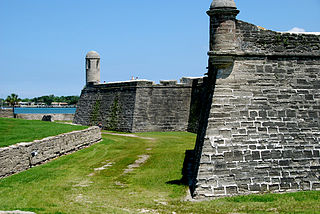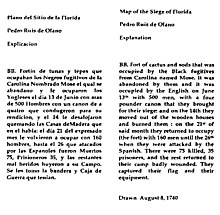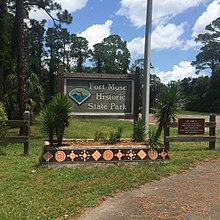
St. Augustine is a city in the Southeastern United States and the county seat of St. Johns County on the Atlantic coast of northeastern Florida. Founded in 1565 by Spanish explorers, it is the oldest continuously inhabited European-established settlement in what is now the contiguous United States.

Slavery in the colonial history of the United States, from 1526 to 1776, developed from complex factors, and researchers have proposed several theories to explain the development of the institution of slavery and of the slave trade. Slavery strongly correlated with the European colonies' demand for labor, especially for the labor-intensive plantation economies of the sugar colonies in the Caribbean and South America, operated by Great Britain, France, Spain, Portugal, and the Dutch Republic.
The StonoRebellion was a slave revolt that began on 9 September 1739, in the colony of South Carolina. It was the largest enslaved rebellion in the Southern Colonies, with 25 colonists and 35 to 50 Africans killed. The uprising was led by native Africans who were likely from the Central African Kingdom of Kongo, as the rebels were Catholic and some spoke Portuguese.

Slavery in the Spanish American colonies was an economic and social institution which existed throughout the Spanish Empire including Spain itself. In its American territories, Spain displayed an early abolitionist stance towards indigenous people, although some instances of illegal Native American slavery continued to be practiced, particularly until the New Laws of 1543. The Spanish empire, however was involved in the enslavement of people of African origin. Although the Spanish often depended on others to obtain enslaved Africans and transport them across the Atlantic, the Spanish Empire was a major recipient of enslaved Africans, with around 22% of the Africans delivered to American shores ending up in the Spanish Empire. Asian people (chinos) in colonial Mexico were also taken from the Philippines and enslaved. They were taken to Acapulco by Novohispanic ships and sold.

Spanish Florida was the first major European land claim and attempted settlement in North America during the European Age of Discovery. La Florida formed part of the Captaincy General of Cuba, the Viceroyalty of New Spain, and the Spanish Empire during Spanish colonization of the Americas. While its boundaries were never clearly or formally defined, the territory was initially much larger than the present-day state of Florida, extending over much of what is now the southeastern United States, including all of present-day Florida plus portions of Georgia, Alabama, Mississippi, North Carolina, South Carolina, and Louisiana. Spain's claim to this vast area was based on several wide-ranging expeditions mounted during the 16th century. A number of missions, settlements, and small forts existed in the 16th and to a lesser extent in the 17th century; they were eventually abandoned due to pressure from the expanding English and French colonial settlements, the collapse of the native populations, and the general difficulty in becoming agriculturally or economically self-sufficient. By the 18th century, Spain's control over La Florida did not extend much beyond a handful of forts near St. Augustine, St. Marks, and Pensacola, all within the boundaries of present-day Florida.

Ximenez-Fatio House Museum is one of the best-preserved and most authentic Second Spanish Period (1783-1821) residential buildings in St. Augustine, Florida. In 1973, it was added to the National Register of Historic Places. It was designated a Florida Heritage Landmark in 2012.
Francisco Menéndez was a notable free Black militiaman who served the Spanish Empire in Florida during the 18th-century. He was the leader of Fort Mose, arguably the first free Black settlement in North America.

The siege of St. Augustine was a military engagement that took place during June–July 1740. It involved a British attack on the city of St Augustine in Spanish Florida and was a part of the much larger conflict known as the War of Jenkins' Ear.
Manuel Joaquín de Montiano y Sopelana was a Spanish General and colonial administrator who served as Royal Governor of La Florida during Florida's First Spanish Period and as Royal Governor of Panama. He defended Florida from an attack by British forces in 1740 and launched his own unsuccessful Invasion of Georgia during the War of Jenkins' Ear.

The Battle of Fort Mose was a significant action of the War of Jenkins' Ear that took place on June 14, 1740 in Spanish Florida. Captain Antonio Salgado commanded a Spanish column of 300 regular troops, backed by the free black militia under Francisco Menéndez and allied Seminole warriors consisting of Indian auxiliaries. They stormed Fort Mose, a strategically crucial position newly held by 170 British soldiers under Colonel John Palmer. Palmer and his garrison had taken the fort from the Spanish as part of James Oglethorpe's offensive to capture St. Augustine.

Negro Fort was a short-lived fortification built by the British in 1814, during the War of 1812, in a remote part of what was at the time Spanish Florida. It was intended to support a never-realized British attack on the U.S. via its southwest border, by means of which they could "free all these Southern Countries [states] from the Yoke of the Americans."
Melchor Feliú (?-1766) was the last governor in the First Spanish Period of Florida's history, governing from March 20, 1762 to July 27, 1763. Feliú oversaw the cession of Florida to Great Britain by the Treaty of Paris on July 21, 1763 and the subsequent immigration of most of the province's Spanish and African inhabitants to Cuba. Some of the Native Americans living in the Spanish Catholic missions also moved away from Florida at this time.
Fulgencio García de Solís was the acting Governor of Florida from 1752 to 1755, and Governor of Honduras from 1757 to 1759.

Slavery in Florida is more central to Florida's history than it is to almost any other state. Florida's purchase by the United States from Spain in 1819 was primarily a measure to strengthen the system of slavery on Southern plantations, by denying potential runaways the formerly safe haven of Florida.
St. Augustine, Florida, the oldest continuously occupied settlement of European origin in the continental United States, was founded in 1565 by Spanish admiral Pedro Menéndez de Avilés. The Spanish Crown issued an asiento to Menéndez, signed by King Philip II on March 20, 1565, granting him various titles, including that of adelantado of Florida, and expansive privileges to exploit the lands in the vast territory of Spanish Florida, called La Florida by the Spaniards. This contract directed Menéndez to explore the region's Atlantic coast and report on its features, with the object of finding a suitable location to establish a permanent colony from which the Spanish treasure fleet could be defended and Spain's claimed territories in North America protected against incursions by other European powers.
Angola was a prosperous community of up to 750 maroons that existed in Florida from 1812 until Florida became a U.S. territory in 1821, at which point it was destroyed. The location was along the Manatee River in Bradenton, Florida, near Manatee Mineral Springs Park. The exact location is expansive, ranging from where the Braden River meets the Manatee River down to Sarasota Bay; archaeological research focuses on the Manatee Mineral Spring—a source of fresh water and later the location of the Village of Manatee two decades after the destruction of the maroon community. Archaeological evidence has been found and the archaeology report by Uzi Baram is on file with the Florida Division of Historical Resources of the Florida Department of State.
Kathleen A. Deagan is an American archaeologist who primarily focuses on excavations in Florida and the Caribbean. Known for her historic archaeology which uncovered the colonial past of La Florida, and work in St. Augustine, she has received multiple awards and honors, including the Award of Merit in 1992 and the J. C. Harrington Award in 2004, both bestowed by the Society for Historical Archaeology.
Jane Gilmer Landers is an historian of colonial Latin America and the Atlantic World who specializes in the history of Africans and their descendants. She is the Gertrude Conaway Vanderbilt Professor of History at Vanderbilt University, Director of the Center for Latin American and Iberian Studies, and former Associate Dean of the College of Arts & Science.
African Americans have made considerable contributions to the history and development of Jacksonville, Florida. According to the U.S. Census Bureau, the population make up of African American in Jacksonville Florida is 68%.

The Martyrs of La Florida were a group of Native American and Spanish Catholics killed in Florida during the Spanish Empire's colonial expansion into North America. The group of 86 individuals includes a number of priests and laypeople, killed by Native Americans and subjects of the British Empire. The lead martyr of the cause is the Native American layman Antonio Cuipa. Fr Luis Cáncer, OP is among the others killed, alongside a number of Dominicans, Jesuits, Franciscans, and various laypeople.



























